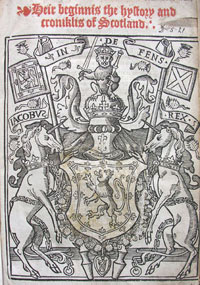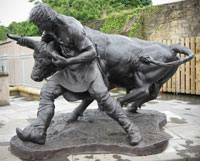In the second in this series, ScotClans’ Rodger Moffet looks at the origin of the crest of this popular and fearsome Border clan – The Turnbulls…

The surname Turnbull shares the attributes of many Scottish surnames in that it relates to a deed performed by an ancestor (or at least that is the popular tale). We first hear this story from Hector Boece, A Scottish Philosopher and Historian who was the first Principal of King’s College in Aberdeen. His ‘Hystory and Croniklis’ of Scotland was published around in the early 1500s.
In the Chronicle we are told of how Robert the Bruce was hunting in the great forest of Caledon in the times just after his coronation. The Caledon Forest is described as stretching from ‘Strivling’ (Stirling) Through Mentieth to Lochaber. The forest was mostly impenetrable and filled with all manner of wild creatures. Large wild bulls, roamed the forest and never having been used to the company of men were extremely aggressive. The small hunting party came upon a large bull and attempted to take it down, however the arrows and lances only wounded the animal and fired it into a rage. The mad bull then charged at the party heading straight for the King himself, The Kings horse was frozen to the spot and, seeing the danger one man lept before the bull, grabbing his horns and diverting the animal just long enough for the other hunters to finish it off.
For this brave deed Bruce called the man ’Turnebull’ – (the ‘e’ later being dropped). He was rewarded with lands for his actions and became the progenitor of the name Turnbull.

But what do we know of the truth behind the story? Was it a fanciful conception or based on real events? Well it all gets rather muddy – what we do know is that a William Turnbull was awarded land in Philliphagh by Robert the Bruce. We also know that the surname ‘Rule’ (the name of the person who had wrestled the bull) dwindles away after 1315 and the surname Turnbull appears at that date and becomes more popular. Also William Turnbull adopted the bull on his coat of arms and crest, and also his motto is ‘I saved the King’. Pretty conclusive eh?
However Boece’s work was produced at a time where considerably more liberties were taken with history than we find acceptable today. Take for instance his history of MacBeth; anyone who has studied history will know that the real MacBeth was a very different character to the one portrayed by Shakespeare. The real Macbeth had a successful reign and was by all accounts a good and just King. However Boece does a hatchet job on Macbeth in an effort to please James IV the King at the time he was working. Shakespeare uses this version of events in his play propagating the lie (Shakespeare did exactly the same thing with Richard III to keep his Tudor patrons happy) Boece’s Chronicle was only the second scholarly work of Scottish history ever completed so he was certainly short on reference material. There have been several studies afterwards that have discredited much of the work of Boece so we really need to be careful.
An alternative is that the name comes from the Old English ‘Trumbald’ or French ’Tumbald’ meaning ‘Strong and Bold’. A Robertis de Turnbulyes swore fealty to Edward I of England in 1296. a good few years before the Turnbull story.
The truth is that we will never really know for sure, so much of what we have come to accept as history is set on flimsy foundations; for example much of what we know of William Wallace is based on the stories by Blind Harry a 15th century minstrel but he references a book that may never even have existed.
This won’t be the last clan name we cover that is based on a deed of some sort there are many others, the origin of Turnbull may indeed be a ‘Cock and Bull’ story but its still a great one.

